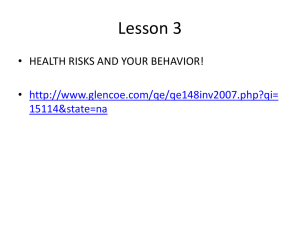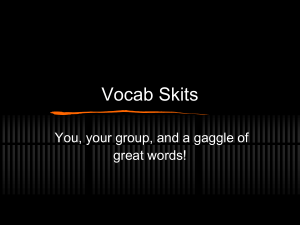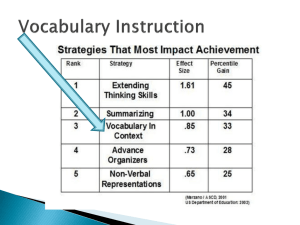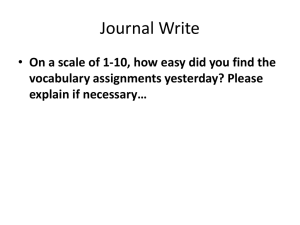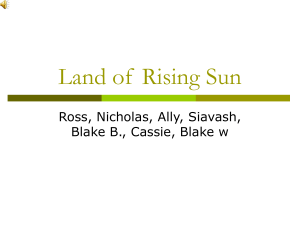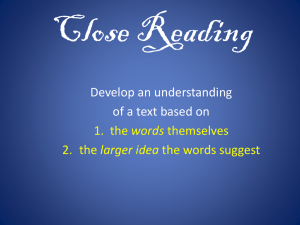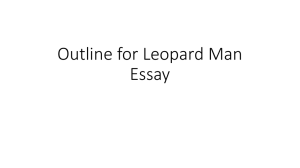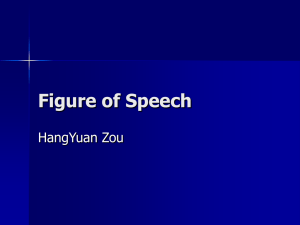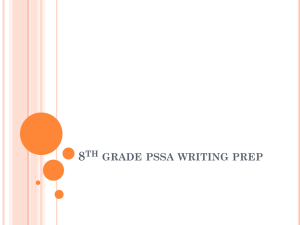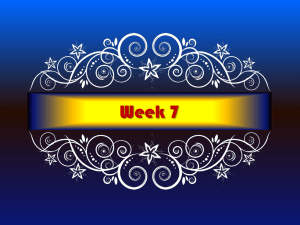Words - WordPress.com
advertisement
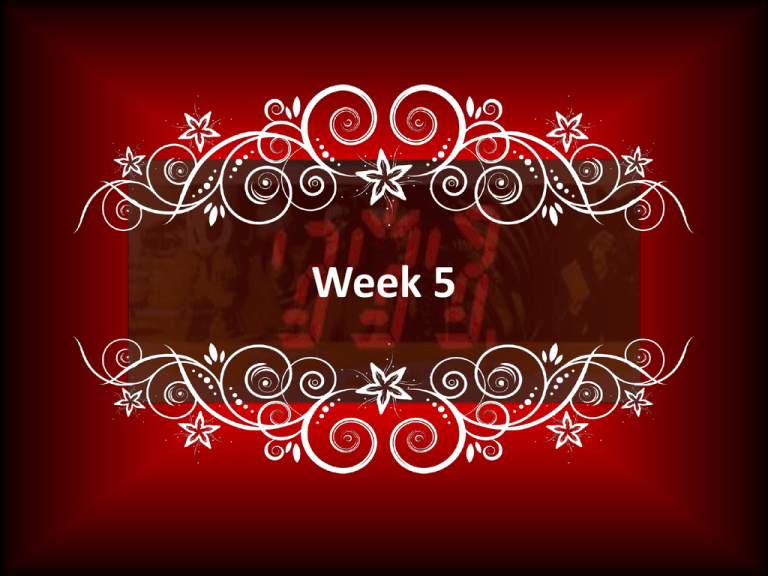
Week 5 Wednesday February 19th JB #4 It is a fact that it’s the characters that make stories memorable, and authors can’t make people feel emotion unless they can make them care about the characters, so what book or which characters do you care about? Why/how? • Objectives: /aka what I’m learning 1) the meaning of 5 new vocab words 2) how to use the new vocab words 3) new tropes and schemes and how to identify and make them 4) how to use rhetoric effectively in words 6) what the say/does relationship is in communication 7) how to identify and practice the say/does relationship 8) surface and deeper reading skills 9) how King wrote in a exemplary manner in Letter from Birmingham jail” 10) reflection on learning making it meaningful • I can review vocab and do the practice for the word(s) so as to be ready for the quiz next Monday I can add to my tropes and schemes booklet notes I can review the rhetoric notes I can continue to read and understand and apply the concept of using “say/does” for analysis, esp. of the MLK image I can practice say/does to email/mail visual I can practice “say/does” to the image on this slide – and share my response I can apply the “say/does” analysis idea to an infographic on education and prisons and complete it for tomorrow I can understand how to construct deeper meanings and surface meanings through practices to the Harper’s Index I can read “Letter from Birmingham Jail” pages 261 – 266 paragraph 19, apply say/does to any 2 paragraphs. I can do SSR for 10 minutes if time permits I can do take away 2.1 • • • • • • • • • • Reminders • AP letter of intent Vocab • 1. garrulous • Garrulous gatherings of students are unwelcome in a library that values silence. • Our sightseeing guide was so garrulous that we never got to enjoy the serenity of the mountain lake. • 2. loathe • No, mom, it’s not that I dislike cauliflower—I loathe it; I hate its smell, its texture, and its taste. • 3. impertinent • He is such an impertinent young man that his teachers are always assigning him detentions for his rudeness. • The spa worker suggested that I sign up for an eye brow wax, saying impertinently, “You are supposed to have two, you know!” • 4. puerile • My little brother is so puerile (burping and spitting milk from his nose) that I don’t ever invite friends over for dinner. • 5. turpitude • His turpitude in taking pictures of the actor’s lifeless body after he was struck by a car shocked even the most callous of the paparazzi. • • • • • • • • • • Vocab XX cont. send to me visuals for review and that action is a demonstration of above and beyond – e.g. =A 1. malapropism When the student said he was sent to the office for using inappropriate languid, I had to smile at his malapropism. 2. maverick He is a maverick when it comes to art—he can create masterpieces from the most unexpected materials—McDonald’s wrappers to used TV Guides; his art is social commentary and recycling. 3. paucity Based on the paucity of evidence connecting him to the crime, I cannot find him guilty of picking the tulips. 4. galvanize The sophomore knew she would have a hard time beating the senior for the position of school secretary, so she tried to galvanize voter-support by saying she would fight for an open campus for underclassmen. 5. quixotic His quixotic attempts to help the environment usually landed him in jail—like the time he broke into all the homes in our neighborhood to collect recyclable goods out of kitchen trash cans. Anaphora Repetition of the beginning of successive clauses or sentences Epistrophe Repetition of the same group of words at the end of successive clauses or sentences Everyday Use Chapter 3 Summary Words: Diction: word choice (Latin dictio = style of speech) Diction depends on situation and genre Ask “What is my purpose, who is my audience, and what kind of text am I writing?” Everyday Use Chapter 3 Summary Words: Formal vs. Informal Diction should fit occasion. Formal: no contractions, no first- or second-person Informal: contractions, first-person, limited second person, slang, colloquialisms Everyday Use Chapter 3 Summary Words: Denotation & Connotation Denotation: literal meaning of a word Connotation: association evoked by a word Make 2 examples of two words used connotatively and denotatively: VL: Author’s intent. Apply says/does to this visual: Thursday February 20th JB #5 What is the role of art in defining a community? • Objectives: /aka what I’m learning 1) the visual interpretation and meaning of vocab words 2) identify and practice tropes and schemes 3) how to effectively use and identify rhetoric 4) share independent practices 5) practice “they/say/I say” with King’s piece 6) understand the nature of MCs 7) reflect on learning for the hour • I can review vocab and do the practice for the word(s) so as to be ready for the quiz next Monday I can add to my tropes and schemes booklet notes I can review the rhetoric notes • • • • • • • • I can share my infographic analysis then hand it in I can share my harper’s Index surface and deeper meanings practice and then hand it in I can share my MLK “say/does” practice with my reading group/whole class, and add the voice lesson from the next slide to it and then hand it in I can focus on the notes about MCs I can finish reading King’s piece and answer questions 7, 10, and 12 from pages 274 – 275 due next class I can do take away 2.2. Voice Lesson: Comments on King’s piece, practicing “they say/I say” • Write to a person about whom you feel is mistaken about his or her ideas on a controversial topic – make an assertion in one sentence. • I can understand how King relies on pointing out the form of what motivates the audience to whom he is writing • He makes overt references to “you” and he responds to them • He reminds his readers of the ideas to which he is responding. • Identify an example of where he uses this technique • Imitate King’s style in writing a response to your previous position topic – defend the position about which you previously disagreed, be the opponent. Will share with the class Garrulous turpitude Impertinent galvanize Anadiplosis: Example: Repetition of the last word(s) in one clause at the beginning of the following clause. A combination of anaphora and epistrophe. Everyday Use Chapter 3 Summary Genres: Genres are types of compositions, based upon context and purpose. Each genre has its own set of rules. No single pattern will work in all situations. However, all texts have a beginning, middle, and end. Everyday Use Chapter 3 Summary Genres: Beginning: States central argument or poses central question. Preview of text development Middle: Supports central argument / Answers central question End: Wraps up the argument. Asks “So What?” Say/does synthesis • Say: Looking at family photos again, he notes that the people look different in the photos taken when he was just a child. Looking at the images, he remembers that back then these people seemed and looked so old, and now they look so young. He then says that his own images strike him as the most strange. • Does: In paragraph 3 the author focuses on particular, personal objects associated with his subject. Extending his observations, he cites a paradox. He then focuses more narrowly on the subject and himself. Say/does synthesis draft, needs stronger topic sentence and some detailing – otherwise great. • In paragraph 3 the author focuses on particular, personal objects associated with his subject; such as when looking at family photos again, he notes that the people look different in the photos taken when he was just a child. Extending his observations, he cites a paradox; looking at the images, he remembers that back then these people seemed and looked so old, and now they look so young. He then focuses more narrowly on the subject and himself when he says that his own images strike him as the most strange. Say/does synthesis • Now apply this to your two King paragraphs • Share with a neighbor • Impressions? Things that make you hmm.. Why is abbreviation such a long word? • • • • • Name the author…name the title: How to build a house Han D. Mann Kip Goin wrote what book? Long Distance Hiking Funsies: Puns • I wondered why the baseball was getting bigger. • Then it hit me. • Did you hear about the guy whose whole left side was cut off? • He's all right now. • I couldn't quite remember how to throw a boomerang, • but eventually it came back to me. • A hole has been found in the bank vault wall. • The police are looking into it. • He drove his expensive car into a tree! Why wasn’t it damaged beyond repair? • Because it was a Mercedes bends. Friday February 21st JB #6 FWFs- about community, eduaction or employmentpent on? Explain why. • Objectives: /aka what I’m learning 1) the vocab words usage and identifying visual representations 2) identify and use tropes and schemes correctly 3) effective usage of rhetorical devices 4) applying analysis to writing and effective analysis of king’s piece 5) practice MC 6) reflection on learning • I can review vocab and do the practice for the word(s) so as to be ready for the quiz next Monday • I can review the rhetoric notes • I can meet with my reading group and share my answers and responses to King’s piece per directions on the next slides • I can begin the timed writing (40 minutes) on the King piece using the prompt and have it completed before Monday • I can do MC #5 for Monday • I can do take away 2.3 (s)He said – what I think – what was shared • Make 3 columns – label them as follows: what (s)he said; what I think; what someone said in response • Write the name of the sharer, then write your response, then write what someone said in response to the sharer • Everyone will share at least one response for other to respond to • Then below the responses answer this question as a group – all share one answer: •What is King’s main argument? What three reasons does he provide to support his argument? • Answer the five questions as a group from the next slide • Staple all independent work together as reading group packet Group (community) analysis of King’s piece 1. Word Meaning – In the salutation and opening paragraph of his letter, King addresses his audience as “men of genuine good will” and mentions that their concerns are “sincerely set forth.” What is the connection between “genuine” and “sincerely”? What tone do these words and phrases create, and why does King choose to use them? 2. Word Meaning – In paragraph one, King states that he wants to address his audience’s statement “in what I hope will be patient and reasonable terms.” Why does he begin his answer to his audience with these words? What tone does it set for the piece? 3. Key Details – In paragraph two, what does the line “when the hour came we lived up to our promise” imply about King’s character and beliefs? How does this line help strengthen King’s argument? 4. Central Ideas – In paragraph three, whom does King compare himself? How does his comparison support his reason for going to Birmingham and impact the tone of the text? What can you infer about King’s character and his audience based on this comparison? 5. Reasoning/Evaluation – How does the argument King offers in paragraph four fit or relate to the other reasons and evidence he has shared? Staple all independent work together with these answers as the reading group packet loathe • malapropism puerile • maverick Everyday Use Chapter 3 Summary Classical Rhetoric: Six-Part Argument 1. Exordium: “web” or hook 2. Narration: background material / context 3. Partition: what will and won’t be included 4. Confirmation: supports argument 5. Refutation: addresses counterarguments 6. Peroration: conclusion / call to action funsies • • • • • • • • • Creative definition (make it punny): A quarterback is a… Small refund An infantry is… The military unit with the most children Open-toed shoes… The best shoes for finding amphibians Book author: How to Sail By BO Ting Week 6

